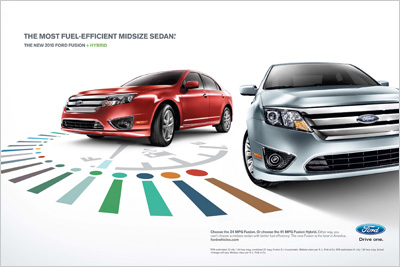
DEARBORN, MI – Ford Motor Co. this year will concentrate its marketing efforts on convincing consumers it is not just a truck maker, but offers a class-leading lineup of cars, as well.
Tonight, during the airing of the top-rated “American Idol” television show, Ford will begin its quest as it airs the first spot in a new ad campaign titled “We Speak Car,” which focuses on the key attributes of the ’10 Fusion midsize sedan.
“Our mission right now is to establish Ford as a car company, as well,” Matt Van Dyke, director-marketing communications, tells Ward’s. “What we did last year with our ‘Drive One’ campaign is to talk about the things that are important to car buyers – the quality, green, safe and smart pillars. And what we really have now is (a campaign) that will really allow us to lean into each one of these (pillars).”
The campaign primarily will focus on fuel efficiency and class-exclusive technology, such as Ford’s multimedia Sync system.
“Eighty percent of people that are aware of Sync have a more positive impression of the Ford brand,” Van Dyke says. “Our Sync technology in this segment has been huge.”
Online and print elements will be added as the campaign rolls out.

While technology is important to consumers in the midsize segment, fuel efficiency is their No.1 concern, Van Dyke says, noting poor fuel economy used to be the top reason consumers rejected the Ford brand.
The new ’10 Fusion with a 2.5L I-4 engine achieves fuel economy of 23/34 mpg (10-7 L/100 km) city/highway, while the Fusion Hybrid is rated at 41/36 mpg (5.7-6.5 L/100 km).
Fuel economy “resonates well in this market, where people are doing the math on their own and figuring out what their vehicle costs are,” Van Dyke says. “Our overall value story is strong, and when people see a ‘4’ in front of a mileage figure it speaks to them”
The ads have an uncluttered look, featuring the Fusion against a white backdrop interacting with colorful computer-generated imagery and graphics.
The TV campaign will include three spots. One will focus on the fuel economy of the 4-cyl. Fusion, while another will highlight the Fusion Hybrid. A third zeros in on technology.
Getting a stronger foothold in the midsize sedan segment is essential for success, says top U.S. sales analyst George Pipas.
Last year, midsize cars accounted for 15% of the total U.S. car market, trailing just the small-car segment with 20%.
Overall, cars made up 51% of the U.S. light-vehicle sales, Pipas says, noting the Baby Boomer generation is increasingly drawn to cars, as is the Millennial Generation, the growing population of 14- to 29-year-olds expected to represent 38% of the driving population by 2010.
Other reasons driving growth in the midsize segment are fluctuating energy prices and social factors, Pipas says, adding much of society has adopted a “take only what you need” mentality.
Ford has been making some headway into the segment, increasing its overall market share from 6.4% in 2007 to 6.5% in 2008.
While not an overwhelming gain, Ford sees it as proof consumers are starting to embrace the company as a maker of midsize cars. In fact, Van Dyke says Fusion is poised to take on segment leader Toyota Camry.
“We think we can (take on the Camry), because of the product attributes we have,” he says, pointing to increased residual values as an indicator Fusion is on the right track.
According to Automotive Leasing Guide, the Fusion’s residual value has increased six points from the ’06 model to the ’10 version.
“For the consumer, stronger residual values mean higher trade-in values,” Pipas says. “It reduces a customer’s cost of ownership.”
Fusion also has been able to attract younger customers. The typical Fusion buyer is 51 years old, while the midsize car segment averages 55. Overall awareness of the Fusion stands at 60%, a percentage Van Dyke wants to increase.
Although Ford has been battered by the same economic headwinds pummeling the entire auto industry, Van Dyke says the auto maker has not made significant cuts to its marketing budget.
“Our 2009 marketing budget is right in line with where our 2008 levels were at,” he says. “And we’ve done work with our dealers to accelerate their spending at the regional level. They still have very healthy advertising budgets.”
Van Dyke declines to reveal the total advertising budget of the Fusion campaign, but says it’s on par with the F-Series launch last year.
The Fusion, set to roll out this month, will start at $19,995 for the front-wheel-drive S model, while the SE trim level bases at $20,545 and the SEL costs $23,975. The high-powered Fusion Sport starts at $25,825, while the all-wheel-drive version begins at $27,675, slightly below the hybrid model’s $27,995 sticker. All prices include destination and delivery.


